Acura TL 2000 3.2 Owner's Manual
Manufacturer: ACURA, Model Year: 2000, Model line: TL, Model: Acura TL 2000Pages: 311, PDF Size: 3.05 MB
Page 251 of 311
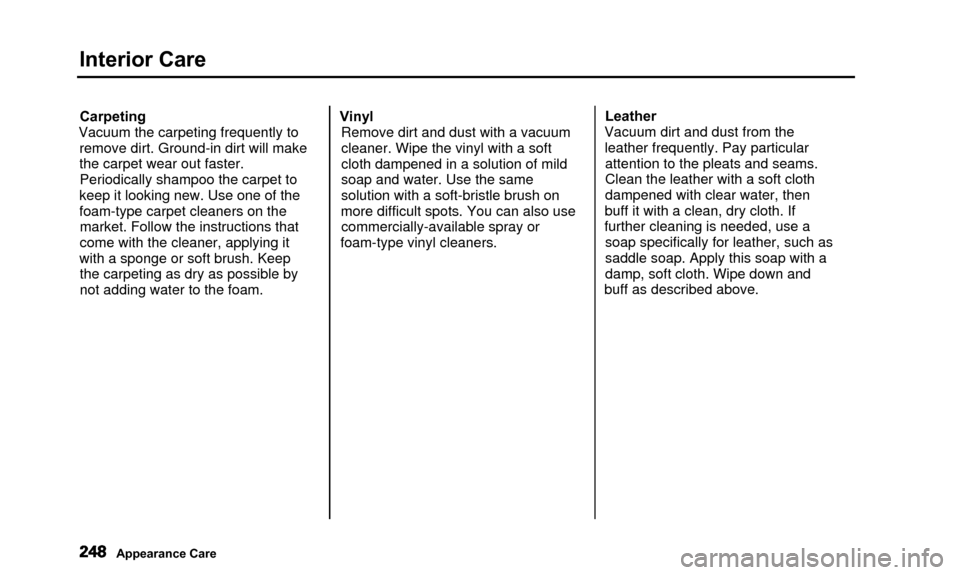
Interior Care
Carpeting
Vacuum the carpeting frequently to remove dirt. Ground-in dirt will make
the carpet wear out faster.Periodically shampoo the carpet to
keep it looking new. Use one of the
foam-type carpet cleaners on the market. Follow the instructions thatcome with the cleaner, applying it
with a sponge or soft brush. Keep the carpeting as dry as possible by
not adding water to the foam. Vinyl
Remove dirt and dust with a vacuum
cleaner. Wipe the vinyl with a soft
cloth dampened in a solution of mild
soap and water. Use the same
solution with a soft-bristle brush on
more difficult spots. You can also use commercially-available spray or
foam-type vinyl cleaners. Leather
Vacuum dirt and dust from the leather frequently. Pay particularattention to the pleats and seams.
Clean the leather with a soft cloth
dampened with clear water, then
buff it with a clean, dry cloth. If
further cleaning is needed, use a soap specifically for leather, such as
saddle soap. Apply this soap with a
damp, soft cloth. Wipe down and
buff as described above.
Appearance Care
Page 252 of 311
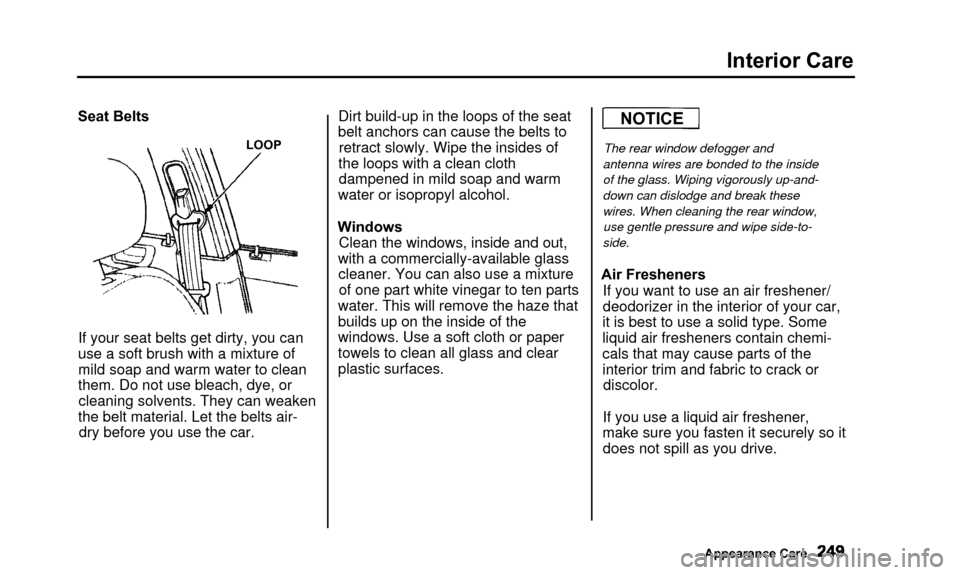
Interior Care
Seat Belts
LOOP
If your seat belts get dirty, you can
use a soft brush with a mixture of
mild soap and warm water to clean
them. Do not use bleach, dye, orcleaning solvents. They can weaken
the belt material. Let the belts air- dry before you use the car. Dirt build-up in the loops of the seat
belt anchors can cause the belts to retract slowly. Wipe the insides of
the loops with a clean cloth dampened in mild soap and warm
water or isopropyl alcohol.
Windows Clean the windows, inside and out,
with a commercially-available glass cleaner. You can also use a mixtureof one part white vinegar to ten parts
water. This will remove the haze that builds up on the inside of the
windows. Use a soft cloth or paper
towels to clean all glass and clear
plastic surfaces.
The rear window defogger and
antenna wires are bonded to the inside
of the glass. Wiping vigorously up-and-
down can dislodge and break these
wires. When cleaning the rear window, use gentle pressure and wipe side-to-
side.
Air Fresheners If you want to use an air freshener/
deodorizer in the interior of your car,
it is best to use a solid type. Some
liquid air fresheners contain chemi-
cals that may cause parts of the interior trim and fabric to crack or discolor.
If you use a liquid air freshener,
make sure you fasten it securely so it does not spill as you drive.
Appearance Care
NOTICE
Page 253 of 311

Corrosion Protection
Two factors normally contribute tocausing corrosion in your car:
1. Moisture trapped in body cavities. Dirt and road salt that collects in
hollows on the underside of the car stays damp, promoting
corrosion in that area.
2. Removal of paint and protective coatings from the exterior and
underside of the car. Many corrosion-preventive measures
are built into your Acura. You can
help keep your car from corroding
by performing some simple periodic
maintenance:
• Repair chips and scratches in the paint as soon as you discover them.
• Inspect and clean out the drainholes in the bottom of the doorsand body.
• Check the floor coverings for dampness. Carpeting and floor
mats may remain damp for a long
time, especially in winter. This dampness can eventually cause
the floor panels to corrode.
• Use a high-pressure spray to clean the underside of your car. This isespecially important in areas that
use road salt in winter. It is also a
good idea in humid climates and areas subject to salt air. Cars
equipped with ABS have a sensor
and wiring at each wheel. Be
careful not to damage them.
• Have the corrosion-preventive
coatings on the underside of your
car inspected and repaired
periodically.
Appearance Care
Page 254 of 311

Body Repairs
Body repairs can affect your car's
resistance to corrosion. If your car
needs repairs after a collision, pay
close attention to the parts used in
the repair and the quality of the
work.
Make sure the repair facility usesGenuine Acura replacement body
parts. Some companies make sheet
metal pieces that seem to duplicate
the original Acura body parts, but are actually inferior in fit, finish, and
corrosion resistance. Once installed,
they do not give the same high-quality appearance. When reporting your collision to the
insurance company, tell them you
want Genuine Acura parts used in
the repair. Although most insurers
recognize the quality of original
parts, some may try to specify that
the repairs be done with other available parts. You should investi-
gate this before any repairs have
begun.
Take your car to your authorized Acura dealer for inspection after the repairs are completed. Your dealer
can make sure that quality materials
were used, and that corrosion- preventive coatings were applied to
all repaired and replaced parts.
Appearance Care
Page 255 of 311

252
Page 256 of 311
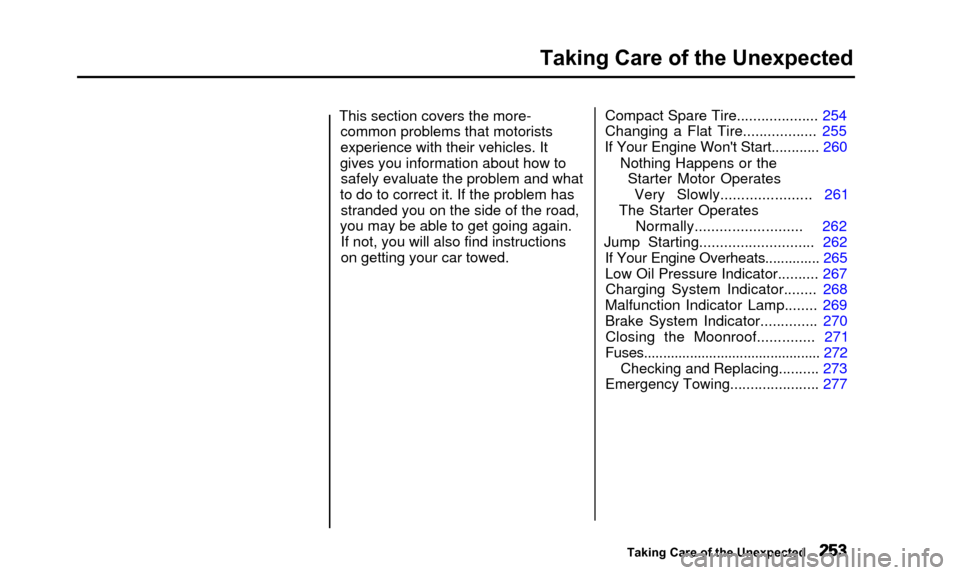
Taking Care of the Unexpected
This section covers the more-common problems that motorists
experience with their vehicles. It
gives you information about how to safely evaluate the problem and what
to do to correct it. If the problem has stranded you on the side of the road,
you may be able to get going again. If not, you will also find instructions
on getting your car towed. Compact Spare Tire.................... 254
Changing a Flat Tire.................. 255
If Your Engine Won't Start............ 260
Nothing Happens or theStarter Motor OperatesVery Slowly...................... 261
The Starter Operates
Normally.......................... 262
Jump Starting............................ 262
If Your Engine Overheats.............. 265
Low Oil Pressure Indicator.......... 267 Charging System Indicator........ 268
Malfunction Indicator Lamp ........ 269
Brake System Indicator .............. 270
Closing the Moonroof.............. 271
Fuses.............................................. 272
Checking and Replacing.......... 273
Emergency Towing ...................... 277
Taking Care of the Unexpected
Page 257 of 311
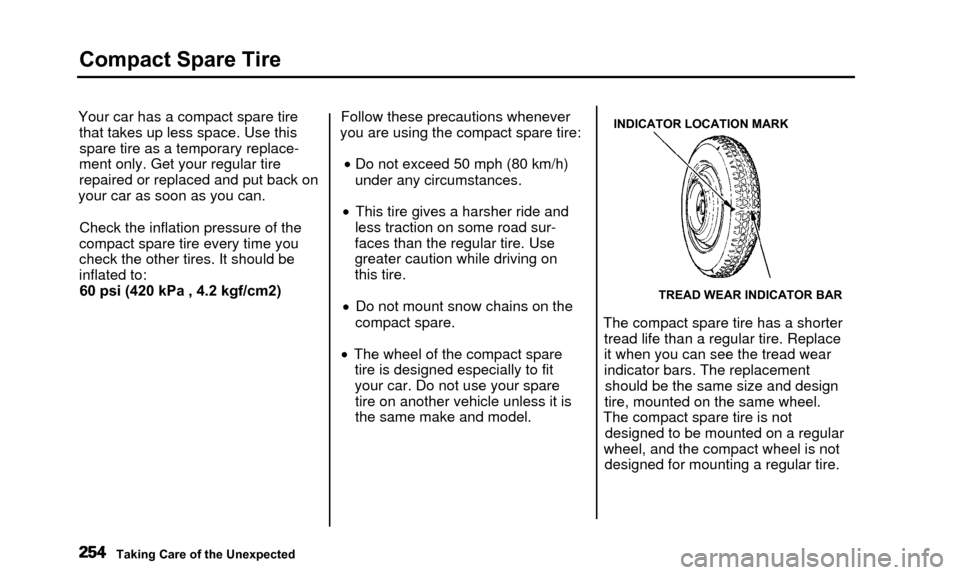
Compact Spare Tire
Your car has a compact spare tirethat takes up less space. Use thisspare tire as a temporary replace-
ment only. Get your regular tire
repaired or replaced and put back on
your car as soon as you can.
Check the inflation pressure of the
compact spare tire every time you
check the other tires. It should be inflated to: 60 psi (420 kPa , 4.2 kgf/cm2) Follow these precautions whenever
you are using the compact spare tire:
• Do not exceed 50 mph (80 km/h)
under any circumstances.
• This tire gives a harsher ride and
less traction on some road sur-
faces than the regular tire. Use
greater caution while driving on
this tire.
• Do not mount snow chains on the
compact spare.
• The wheel of the compact spare tire is designed especially to fit
your car. Do not use your sparetire on another vehicle unless it is
the same make and model.
INDICATOR LOCATION MARK
TREAD WEAR INDICATOR BAR
The compact spare tire has a shortertread life than a regular tire. Replace
it when you can see the tread wear
indicator bars. The replacementshould be the same size and design
tire, mounted on the same wheel.
The compact spare tire is not designed to be mounted on a regular
wheel, and the compact wheel is not designed for mounting a regular tire.
Taking Care of the Unexpected
Page 258 of 311

Changing a Flat Tire
If you have a flat tire while driving,stop in a safe place to change it.
Stopping in traffic or on the shoulder
of a busy road is dangerous. Driveslowly along the shoulder until you
get to an exit or an area to stop that
is far away from the traffic lanes.
The car can easily roll off the
jack, seriously injuring anyone underneath.
Follow the directions for
changing a tire exactly, and never get under the car when it
is supported only by the jack.HOOK
SPARE TIRE TOOL BOX
1. Park the car on firm, level, and non-slippery ground away from
traffic. Put the transmission inPark. Apply the parking brake.
2. Turn on the hazard warning lights and turn the ignition switch to
LOCK (0). Have all the
passengers get out of the car while
you change the tire. 3. Open the trunk. Raise the trunk
floor by lifting up on the back edge.
To keep the trunk floor out of the way, attach the hook into the slot in the trunk lid.
4. Unscrew the wing bolt and take the spare tire out of its well.
5. The tools are in the tool box on the right side of the trunk. Takethe tools out of the tool box.
CONTINUED
Taking Care of the Unexpected
TRUNK FLOOR
JACK
Page 259 of 311
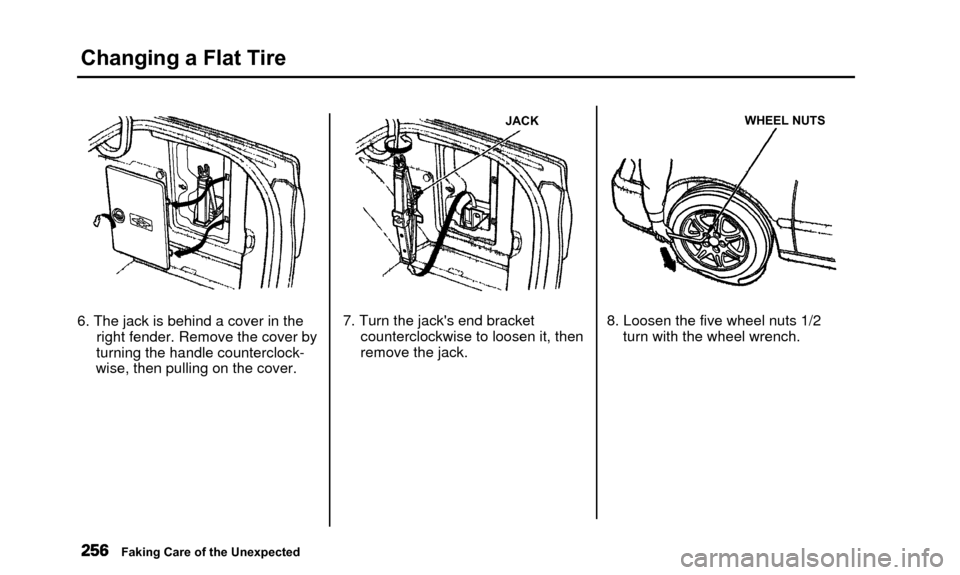
Changing a Flat Tire
6. The jack is behind a cover in theright fender. Remove the cover by
turning the handle counterclock-
wise, then pulling on the cover.
JACK
7. Turn the jack's end bracket counterclockwise to loosen it, then
remove the jack.
WHEEL NUTS
8. Loosen the five wheel nuts 1/2turn with the wheel wrench.
Faking Care of the Unexpected
Page 260 of 311
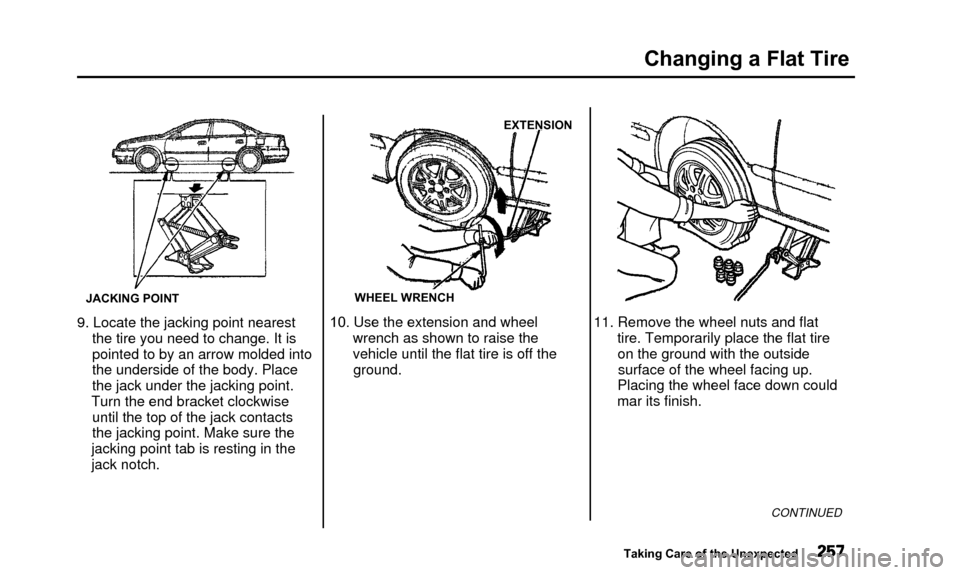
Changing a Flat Tire
JACKING POINT
9. Locate the jacking point nearestthe tire you need to change. It is
pointed to by an arrow molded into
the underside of the body. Place
the jack under the jacking point.
Turn the end bracket clockwise until the top of the jack contacts
the jacking point. Make sure the
jacking point tab is resting in the
jack notch.
WHEEL WRENCH
10. Use the extension and wheel wrench as shown to raise the
vehicle until the flat tire is off theground. 11. Remove the wheel nuts and flat
tire. Temporarily place the flat tireon the ground with the outsidesurface of the wheel facing up.
Placing the wheel face down could
mar its finish.
CONTINUED
Taking Care of the Unexpected
EXTENSION